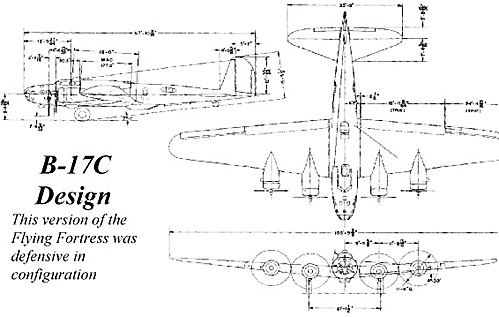The B-17 Arrives
The first flight of the Y1B-17 was on December 2, 1936. Because it had been built using different engines it performed better than the original 299. However, as it rolled down the runway after landing, the pilot hit the brakes too hard. They heated up and fused causing the plane tip over on its nose. Again critics said it was too much plane and funding was nearly stopped before the Army had taken delivery. Funding resumed after a congressional investigation and the Army started receiving the first planes in March, 1937. By August they had taken possession all 13 planes, one of which was a static model destroyed during stress tests. The AAC then used the Y1B-17 in a number of public relations events. In February of 1938 the plane was flown to Argentina on a much publicized Good Will mission for the inauguration of that country's president.
In May the Y1B-17s were sent 700 miles out into the Atlantic to intercept the Italian cruise liner REX. The mission was executed flawlessly and confirmed the validity of the AAC's main mission for heavy longer range bombers , namely the interception of an enemy naval force still many miles out at sea. Unfortunately the stunt backfired. The Navy was outraged and verbal orders quickly came down that the squadron of heavy bombers was to remain within 100 miles of the coast. In January of 1939 the Army took delivery of the Y1B-17A. Only one of these was ever built, but it proved to be a major improvement over the first 13 aircraft. The main reason was that the engines were now supercharged and the operational ceiling of the aircraft was increased to an astounding 38,000 feet.
Unfortunately, even with such successes and the AAC's obvious delight with the plane, purchase orders for the B-17B was a mere 39 planes. At the same time the Army began pressuring Boeing to cut the price of the bomber. Once again Boeing faced a shaky financial future. A follow-up order for the B-17C was a mere 38 bombers. This nearly drove Boeing to bankruptcy and they considered abandoning the B-17 altogether. Then on September 1, 1939, war broke out in Europe. It was to change the future of both the B-17 and Boeing.
Initially there was little change, but with collapse of Poland concern in Washington over the course of the war steadily grew. Nervously the White House noted that the US Army Air Force (USAAF) was ranked 5th in the world. In May 1940 President Franklin D. Roosevelt asked Congress for additional funds for weapons. At the same time Boeing began talks with the Army over the construction of a new, secret, heavy long range, pressurized bomber which later became known as the B-29.
When Belgium surrendered the Army realized that it could no longer wait for the new bomber. With the C and D models still on the assembly line drastic modifications to the B-17 were proposed. Until this point the Fortresses primary role had been considered defensive. Now the USAAF wanted a bomber that could be used offensively. Boeing engineers responded quickly. The B-17 was augmented with a twin tail gun position, powered gun turrets above and below, armored crew positions and a general upgrade of all its guns to .50 caliber. The new B-17E model had been designed in a few short days. As the Germans overran France, Boeing received orders for hundreds of these bombers and began a major plant expansion.

More B-17 Flying Fortress
-
B-17: Introduction
B-17: The 299: Triumph and Disaster
B-17: Y1B-17
B-17: The Fortress I
B-17: The Pacific
B-17: Europe
B-17: Gotterdammerung
Back to Cry Havoc #16 Table of Contents
Back to Cry Havoc List of Issues
Back to MagWeb Master Magazine List
© Copyright 1996 by David W. Tschanz.
This article appears in MagWeb (Magazine Web) on the Internet World Wide Web. Other military history articles and gaming articles are available at http://www.magweb.com